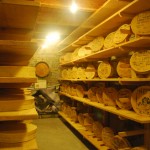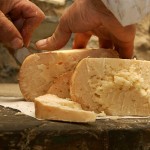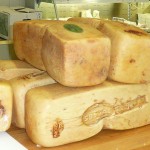Taste this renowned cheese, an incredible local speciality
Valtellina: The Casera cheese
Taste the historical gastronomic tradition of the Valtellina
Italia Slow Tour in Valtellina: we visit a Cooperative Dairy in Delebio, producing the local cheese Casera, a PDO product that represents the historical gastronomic tradition of the Valtellina.
The cheese is made from the milk taken from the cows when they return to the barn, let’s see all the stages of its production till the cheese get mature.
⇒ Watch the full web serie Valtellina Slow Tour
Video full text: Casera cheese
This is the Cooperative’s outlet, where the Casera is produced.
A local cheese from the Valtellina.
Hello there, I wanted a Casera!
Ordering the cheese is quick, but how is it made?
Let’s go and find out!
We are at the Cooperative Dairy in Delebio,
where all the milk producers have joined forces so as to become competitively stronger.
They have created this dairy, where the milk for making the cheese is delivered.
And what a cheese! It’s a PDO product that represents the historical gastronomic tradition of the Valtellina.
What type of cheese do you make here?
This is the Valtellina Casera.
The cheese is made from the milk taken from the cows when they return to the barn.
This is the first stage of production.
The milk has been poured into the vat and the rennet and selected milk ferments are added.
He’s the youngest of the cheese makers, he’s only twenty.
I began working here eighteen months ago and I’m beginning to learn,
it’s a huge responsibility!
Has it reached the right consistency? Let me see.
You have to know when to recognise that the renneted milk has reached the correct density.
It’s time to perform the so-called cut to make the curd.
Let’s start cutting the curd.
This is the next stage in production:
when the cheese maker decides that the grain of the curd has reached the right consistency,
it’s time to empty the contents out and send them to the shaping tank.
You say it as well: let’s start emptying!
The tiny grain that has been formed, the curd’s grain is emptied out.
It’s placed here, where it takes its shape.
Can I try it? It’s very sweet, almost like milk.
Francesco, the cheese maker, explains to me that once it has reached the shaper
the cheese is automatically cut,
released with a strong jet of air and placed into special moulds and pressed.
This is the last stage of production,
it is placed into a marking mould that identifies it as a Valtellina Casera PDO.
It is then placed onto wooden boards until the next morning,
and flipped over during the day.
After the salting comes the maturing, which in the case of the Valtellina Casera lasts for at least 70 days.
How many do you make a day?
We make around 500 to 600 semi-hard cheeses.
There’s plenty of cheese to eat here! Get to work then!
This beautiful bicycle was used between the First and Second World Wars, to bring the milk churns to the dairy.
Will you offer me a piece of cheese then, Marco?
But of course!
After 70 to 90 days it becomes like this.
There’s also another type of maturing that is arousing a great deal of interest,
a 300-day-old cheese.
So how are we doing in Europe?
It’s an opportunity, but we need to persuade ourselves more of this.
We’ll be at EXPO on more than one occasion, so we hope to get ourselves noticed!
And whilst you’ve been talking I’ve also had some of the mature cheese. It’s good!














